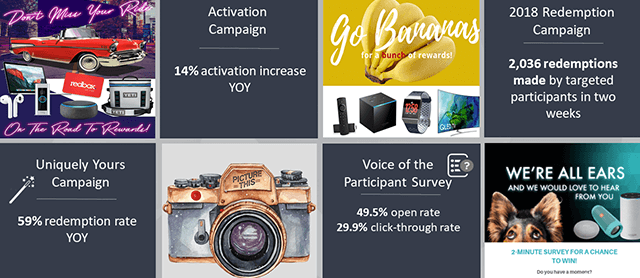Hey everyone! Are you interested in learning how to use your incentive program as a complete loyalty marketing platform? One that drives desired behaviors and educates your partners? One that spreads brand awareness and creates relationships that grow your business? One that gives you access to new insights and data to drive your marketing campaigns?
Your loyalty program is actually the perfect marketing platform…after all, your participants are already engaged by the chance to earn great rewards! A few weeks ago, I had the privilege of presenting best practices for loyalty marketing and incentive programs communications to a select group of sales and marketing leaders at the BthruB 2019 Leadership Conference. Today, I have the privilege of sharing them with you!
In the SlideShare below, I’ll be sharing some of the strategies, tips, and insights, I’ve learned as Marketing Communications Specialists at Incentive Solutions. Are you ready to take your loyalty marketing campaigns to the next level?
Loyalty Marketing & Incentive Program Communications Best Practices
SlideShare Speaking Notes
Slide 1 – Introduction
Hi, I’m Stevie Petri, Marketing Communications Specialist at Incentive Solutions. The Marketing Communications Specialist is a role that was created 5 years ago – to communicate with end-users as part of our commitment to our clients. The Marketing Communications Specialist is where account management and marketing come together. My job is to be a resource for our clients, to manage their communication with participants, and to help design end-to-end loyalty marketing Campaigns.
Slide 2 – Importance of Loyalty Marketing
Did you know that 63% of high performing marketers are using a loyalty program? This is projected to grow to 80% within the next 2 years.
Slide 3 – The Competition
This means that your competition is already using a loyalty program, and it’s up to you to create a better customer experience in order to stand out.
Slide 4 – How Do You Stand Out?
Stand out by delivering an experience that sets you apart in the eyes of your customers, resulting in loyal customers that advocate your goods and services. After all, customer loyalty is a precious commodity.
Slide 5 – Funneling Your Loyalty Marketing
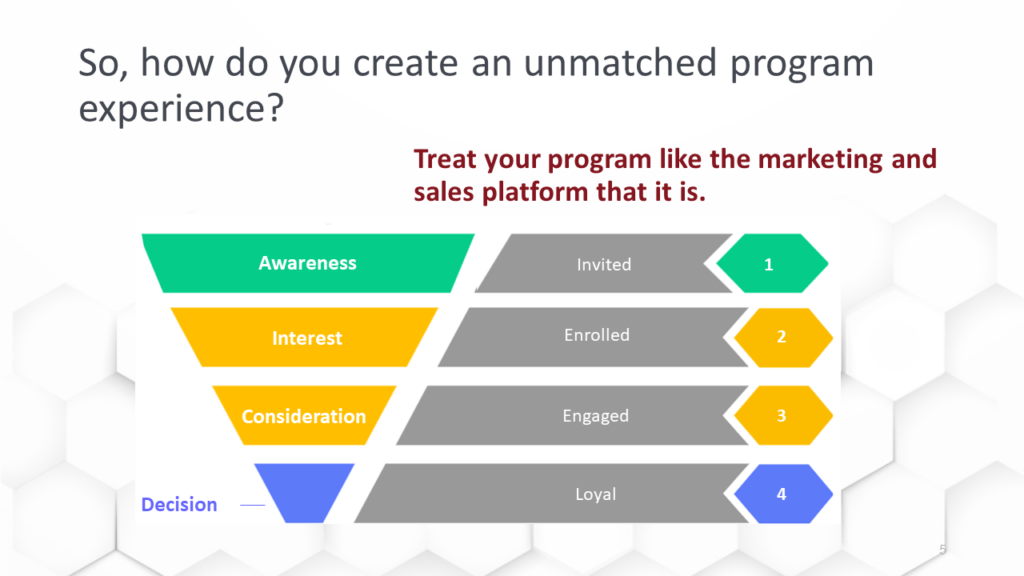
You should treat your loyalty program like the sales and marketing platform that it is. Let’s start by looking at the old marketing funnel & establish where we may be falling short. Like the buyer’s journey, your participants bought into your incentive program and will go through the phases of the marketing funnel.
You should be running full campaigns with multiple communications touch-points for each phase of the marketing funnel. It’s important to maintain a good relationship through all phases of the funnel, throughout the program’s lifecycle.
Slide 6 – Communications Strategy Across the Program Lifecycle
- Intro – 1st year of the program: During the introductory phase, you should be building awareness. This stage is about creating your “brand” and generating excitement about the program. Here, you should be communicating with participants frequently to drive home a consistent message.
- Growth – Years 1.5-2 – During the growth phase, you should focus on segmenting your audience based on their performance and engagement levels. This will help you personalize the program experience for each participant, implement training opportunities to increase performance, and offer them new award opportunities.
- Maturity – Years 3-4 – Here, you will begin to evaluate the success rate of the program and possibly begin planning for program relaunch.
- Decline/Expansion – Years 4-5+ – Depending on the decisions you’ve made throughout your program’s lifecycle and how effectively you’ve executed your community strategy, here your program will either expand or decline.
Slide 7 – The Standard Communications Plan
The Standard Communications Plan is our investment in you. We run three multi-touchpoint campaigns to keep your participants engaged, consisting of a postcard, email, and phone call with a campaign theme. Many programs rely on this instead of running true end-to-end campaigns. However, the Standard Communication Plan isn’t enough to maximize engagement with every segment of your audience throughout the lifetime of your program.
Slide 8 – Types of Loyalty Marketing Campaigns/Results
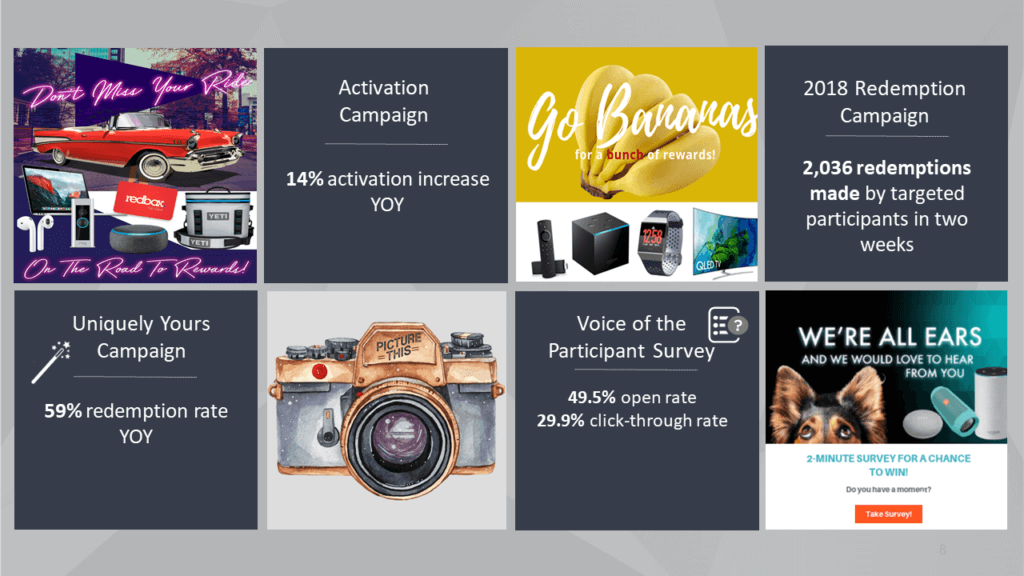
- The Activation Campaign is used to get participants enrolled in your program. It starts with a postcard, using imagery that really stands out. This is followed up with an email, and then a supporting phone call. This has resulted in a 14% YOY increase in enrollment.
- The Redemption Campaign used an interactive mailer with a banana that recipients could peel off to see imagery of rewards. This resulted in 2,036 redemptions by target participants in 2 weeks.
- Uniquely Yours is a program to let high-earning participants know about their option to redeem for rewards outside of the catalog. It consists of a campaign and a phone call. Participants are super excited about this campaign – it has resulted in redemptions for Ford F150s for the company, engagement rings, and trips to Disney resorts. Incentive Solutions works with vendors to make this happen. This mailer was interactive – almost a trifold – with pictures of real participant redemptions, as well as testimonials. The Uniquely Yours campaign resulted in a 59% redemption rate.
- The Voice of the Participants Survey is a chance to get valuable feedback and demographic data from participants. It resulted in a 49.5% open rate and a 29.9% click through rate.
Slide 9 – Imagine the Possibilities
Now that you’ve seen those stats, imagine the impact a well-planned, end-to-end marketing campaigns could have on your program. With our audience today being made up of 80% marketers, I’m not here to tell you how to plan your end-to-end campaigns, but I can share some best practices to help shape your program marketing strategy.
Slide 10 – Evaluating Communications Objectives
Let’s evaluate our current communications objectives…
- Do you know your audience?
- Do you have clean data?
- What are you doing to continuously drive engagement?
- What mediums are you using for communication?
- What is your program Marketing budget.
If you don’t have the answers to most of these questions, we may have a problem. But not to worry… I’m here to help!
Slide 11 – Analyzing Audience
So who are you communicating with? Are they contractors or sales reps? How old are they? What do they like? Do they respond better to email or text? It’s important to know your participants.
Slide 12 – Loyalty Marketing Across the Generations

There are currently 4 to 5 generations in the workplace. It’s crucial that you present them with targeted communications that tend to their individual needs and preferences. Your audience is always changing, not just in age but in the way they communicate. This change is not gradual, it’s immediate. Each one of your participants is different. How do you know if you’re delivering the right messages to drive the behaviors you want?
Slides 13 & 14 – Importance of Data
You need accurate data in order to reach participants and market to them effectively. In my experience in the last two years, 56% of eligible participants have had to be removed from campaigns due to bad data. Imagine the impact that audience could have had on your program.This is why it is crucial to maintain an up-to-date database of each participant.
Slide 15 – Keeping Data Clean
Here are a few tips for maintaining an accurate data base:
- Assess your data on a regular basis. If you can’t trust your data, you won’t be able to create a targeted campaign or message to engage your different audiences. This is especially important for debit and gift card programs, to ensure they are delivered to the right place.
- Dirty data wastes your time and will cost you in the long run at the high price of lost opportunities and wasted resources.
- Set clean-data standards with your participants by reminding them to regularly update their data – you can do this with profile update reminder emails or using the announcement feature on your loyalty program website.
- Clean data helps us run more effective campaigns on your behalf.
Slide 16 – Data Integration
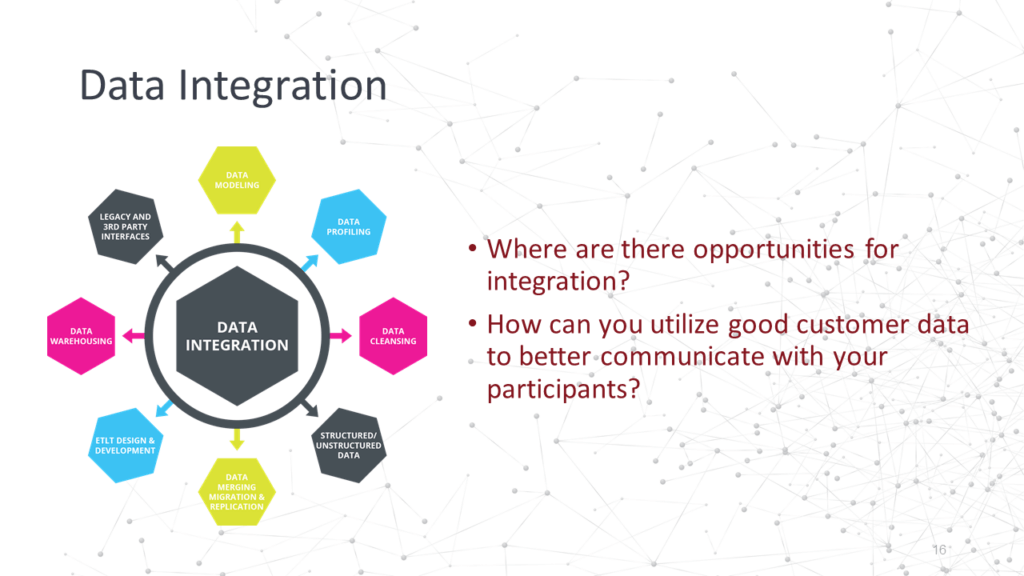
It’s also important to make sure your data is accessible. Where are there opportunities to integrate that data? What kinds of data would be beneficial to push and pull between your platforms? Do you have all your data in one place?
If you’re already collecting good customer data, where are there opportunities to use this data to better communicate with your participants? Be thinking about these things and ask your AM’s about custom integration opportunities.
Slide 17 – Participant Surveys
Surveys are a good opportunity to get feedback from participants, to make them feel like their voice is heard, and to get to know them. Find out what they need to be successful. Providing enablement will help improve relationships and working partnerships with participants. This is also a great way to collect demographic data (optional to the participant of course). Most participants don’t mind sharing demographic data, if you frame it in the right way, especially since they know you’re investing in them.
During our 2018 Voice of the Participant Survey, across all programs, we found that:
- 79% of participants were between the ages of 35-54.
- 67% were male.
- 56.2% were married.
- Top interests were travel/vacation and recreational sports.
You can use this sort of data to shape future campaign initiatives.
Slides 18 & 19 – Keep Your Program Exciting!
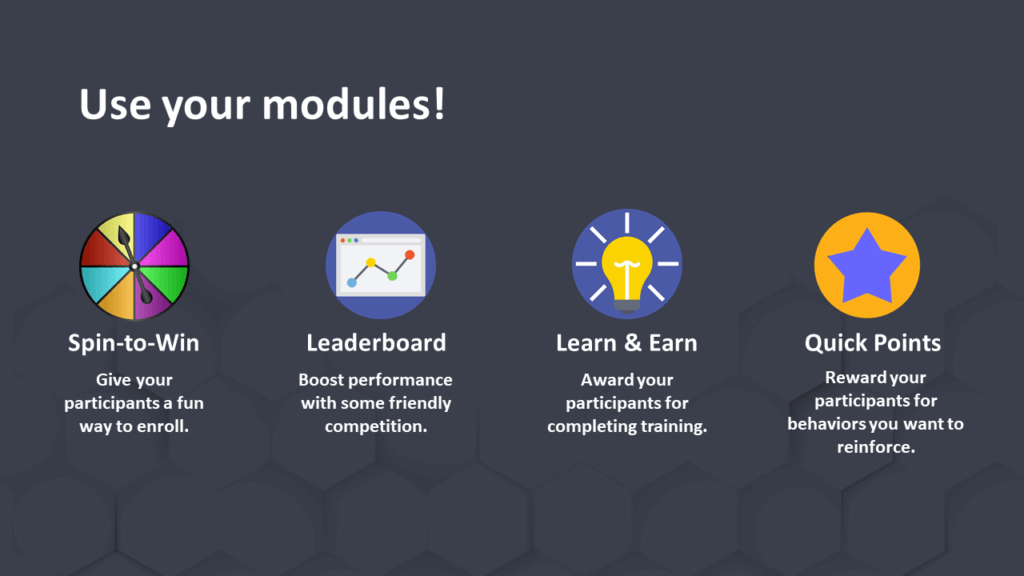
Aside from participant surveys, there are many ways to keep your program fresh and exciting, and to enhance the participant program experience. Whether it’s awarding participants points for enrolling with Spin-to-Win or educating your participants through fun daily trivia, incentive software modules can be used to drive engagement.
Do you have a training plan in place? Are you setting your participants up for success and giving them opportunities to be rewarded? Incentive software provides more than just engagement tools – they can turn your loyalty program into a platform to target the long-term goals of your business.
Slide 20 – Mobile App
If you’re using the Mobile App, are you promoting it effectively? From recent program reports, adoption rates have been dismal for certain programs. Using a campaign that utilized emails, post cards, download promotions, and push notifications with limited-time offers, a recent campaign was able to produce a 44% adoption rate in just 9 weeks. If you’re not using the Mobile App, should you be? The Mobile App can be a powerful tool to communicate with participants.
Slide 21 – Inspiration for Your Loyalty Marketing
Here are a couple points of inspiration for your program:
- Host new contests and promotions to get your middle 60% of performers engaged. Make sure promotions are designed so that everyone has a chance to win. You can do this by setting up prize tiers. Possible offer travel incentive for top performers, or set up a raffle so that every time a rep makes a sale they entered in for a chance to win a trip to Hawaii.
- Amp-up engagement during slower seasons. Run seasonal campaigns that show the types of fun experiences people can have through their rewards programs. The holiday season is a great time to market your card programs. Use messaging like “Sell more, earn more, and use your funds for your holiday shopping – your wallet will thank you!” The more you can entice them to spend their cash on experiences, instead of on gas and bills, the longer they’ll stay engaged.
- Celebrate your participants’ wins. This could be as simple as a thank you card or letting top performers choose from a variety of gift options. We’ve sent out many appreciation mailers on our client’s behalf with gifts ranging from Google Minis and YETI coolers to personalized giftboxes with a variety of items relating to a theme.
- Send year-in-reviews to show participants where they exceeded and where they can improve. Show them that you’re paying attention and encourage them to meet their goals. This can help make program relaunches even more profitable!
- Send out annual surveys to get feedback. Make sure participants are enjoying the new promotions and the program overall! This is a great way to get to know your participants a little bit. Ask them what you need to know to pin-point your next move.
Slide 22 – Utilize Direct Mail

Personalized direct mail is easy, inexpensive, powerful touchpoint that is underutilized. Direct mail averages a 4.4% response rates, compared to a response rate of .12% for email (Direct Marketing Association). It serves as the perfect compliment to your digital marketing campaigns If you’re unsure if direct mail is a successful medium for your audience, include a campaign-specific URL on your postcard that leads your audience to a custom landing page on your website. This is a great way to build excitement for a trip or promotion and gives your audience something tangible and memorable, and lets you deliver a call to action that doesn’t get lost in the shuffle of an email inbox.
Slide 23 – Email Marketing for Your Incentive Program
Email has been a very effective medium for us with the Standard Comm Plan. On our monthly statement emails, we consistently achieve open rates that are 18% higher than industry averages, and click-through rates that are 9.3% higher than industry average. We have achieved this success by frequently A/B testing our email templates, along with different CTA’s, colors, imagery, subject line, to evaluate which emails perform better based on each of those variables. We also test our emails so we that can see what they look like on each screen across 90+ service providers and devices. Each email goes through spam testing and URL validation.
I’ve learned that our audience responds best to emails with two CTA buttons (one at the top, under the header text and one at the bottom below the CTA header). The most effective imagery we’ve found is one hero image showcasing catalog merchandise (vs. lifestyle imagery or multiple images). You should be using email within your rewards program as an opportunity to market to your participants – often this audience is most receptive to your messaging, since it is backed by an opportunity to earn rewards.
Slide 24 – Loyalty Marketing Budget
Your loyalty program communications budget shouldn’t be treated any differently than the money you spend on marketing your brand. You should be allocating 10-20% of your loyalty program budget for marketing and communications (Incentive Marketing Association). So if you don’t have a budget, get one. If you are having trouble getting that budget, collect your data, create your case, and develop a campaign plan your decision-makers can buy into. You should be evaluating this budget quarterly, based on the performance of your program.
Slide 25 – Key Takeaways
One thing I’ve learned from my experience as your trusted communications resource, is that communications can be one of the most crucial factors in providing the best program experience for your participants. Here are a couple times for your program:
- Go beyond the Standard Plan to market your incentive program – your program isn’t mean to be kept quiet. Run end-to-end campaigns that will keep participants engaged and excited.
- Know your audience. If you don’t, take the time to learn more about them. Find out what they like so you can target them with content catered to their individual needs. Don’t be afraid to ask them what you want to know!
- Utilize your incentive software modules. There are resources at your fingertips for you to engage, educate, enable, and drive your participants to your website.
- Assess your data – this can help you determine your communications objectives. It’s scary how much impact bad data can have on your good opportunities.
- Get yourself a marketing budget so that you can give your program the tender love, and care that it needs.
- And, lastly, evaluate your wins and losses along the way. What’s working? Build on it. What isn’t? Get rid of it – don’t waste time.
It’s not hard to create the best program experience and let your participants know that you’re the best. Effective communication is what establishes trust and creates loyalty.
Looking for More Incentive and Loyalty Program Best Practices?
Check out The BthruB Incentive Program Playbook! If you’re serious about creating an effective loyalty program, this free e-book is chocked full of structure, strategy, and tips!

